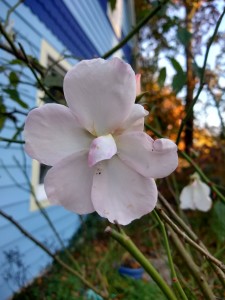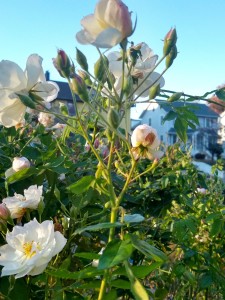 Some people are party animals. They may arrive early or late, but they always stay to close the place down. I have some roses like that. Now that the fall garden party is almost over, they are still awake and alive, dancing in the cold wind, putting on an exuberant show of new growth and generally behaving as if there is no tomorrow.
Some people are party animals. They may arrive early or late, but they always stay to close the place down. I have some roses like that. Now that the fall garden party is almost over, they are still awake and alive, dancing in the cold wind, putting on an exuberant show of new growth and generally behaving as if there is no tomorrow.
I don’t know if there is any research on the longest-lasting garden rose varieties, but at my place, the party animals are all white-flowered. One is ‘Sally Holmes’, a well-loved modern hybrid musk with large, single white flowers surrounding golden centers. Another is a nameless, cluster-flowering white rose with a pronounced spicy fragrance. The blooms are small, but fully double. In mid-November they are still numerous. A spray from this plant is an instant bouquet. The third rose is ‘Pax’, another hybrid musk that turns 100 years old this year. ‘Pax’ is one of the most vigorous rose bushes I have ever encountered and has to be pruned back several times during the growing season. Cold does little to deter its lively nature.
‘Sally Holmes’ is awfully virtuous for such a relentless partier. Guidebooks call the variety a “shrub rose”, but ’Sally’ has the disposition of a social climber. Rising six to 12 feet, the rose sends out very long canes adorned by small clusters of elegantly pointed, pink-tinged buds. These open to blooms that are almost flat, staring the gardener directly in the eye. If sun is at a premium, the rose can get along with very light shade. No matter what the light situation, ‘Sally’ also has the sturdy constitution of a socialite who can dance all night and still get up the next morning. I have never known a ‘Sally Holmes’ rose to be afflicted by that scourge of humid climates, black spot. Bees love the rose, but Japanese beetles and aphids seem a little less
interested. To add to that list of merits, ‘Sally’ has the longest vase life of any rose that I grow. At this time of year I have to resist the temptation to cut off all the remaining buds and open flowers for indoor arrangements.
The anonymous white is supported by the skeleton of a long-deceased yew. It looks to me like a polyantha rose, distinguished by upright clusters of small, pinky-white buds that open into exuberant little one-inch flowers. The canes have very few thorns, which is a definite plus; since my shrub is near the path I use to get to the outdoor tap. Of my three party-goers, it is by far the most fragrant and stays the longest. This may have something to do with its location close to the house, or it may simply be more cold tolerant than its kin. It is generally not the first to bloom in the spring, but its ability to carry on long after the larger roses have gone to bed, makes it highly desirable.
Many roses are named for that most elusive state of being—“peace”. Pemberton most likely christened his promising white seedling rose ‘Pax’ to commemorate the end of World War I. In my garden, it will be blooming on Armistice or Veteran’s Day, November 11. That seems rather fitting.
‘Pax’ is a large shrub, growing five feet tall and spreading in all directions, if it is allowed to do so. It blooms almost continuously throughout the growing season and keeps going until the hardest frosts hit. Unlike ‘Sally Holmes’ and my presumed polyantha, ‘Pax’ does not do well as a cut flower. The little buds and blooms look good for a day at most, before shattering into a cascade of white petals. This is probably a blessing in disguise, because I leave most of ‘Pax’s flower sprays on the bush to keep the garden looking a little more lively in late fall.
People who talk about the fussiness of roses have never attended my late season garden party. When I fertilize the shrubs at all, I stop at the end of August. The absence of supplemental food does not seem to induce ‘Sally’ and her two friends to leave the scene.
Ultimately even the longest running rose party will come to an end. But at a time of the year when daylight is at a premium, it is nice that a few roses stay until the last dance.
